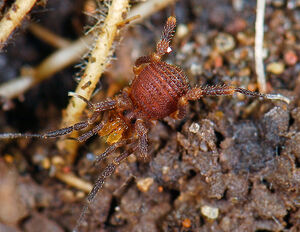| Samoidae | |
|---|---|
 Pellobunus insularis Banks, 1905 - Costa Rica - from flickr. Copyright © M Hedin [Marshal Hedin] | |
|
Suborder |
|
|
Infraorder |
|
|
Superfamily |
|
Samoidae Sørensen, 1886 is a family of Grassatores with 22 genera and 48 species, with a disjunct distribution in the Neotropics/Nearctic plus Australasia.
Characterization [1][]
- Size: Small to medium-sized harvestmen; body length: 1.9–5.5 mm.
- Dorsum: Body as an asymmetrical hourglass, anterior half much shorter, posterior half rounded, laterally convex appearance (Figures 4.37a,b). Ocularium present, in Samoa, Badessa, Feretrius, and Zalmoxista low and wide, in Kalominua narrower and taller, in Akdalima and Reventula wide and ending in an acute spine, in Arganotus developed, elliptical, convex, and projected as a low cone bearing an apical spine, and in Pellobunus a very low cone. Body low (almost smooth) or densely covered with low rounded granules (Figures 4.37a,b). Mesotergum with four areas poorly defined, unarmed (Figures 4.37a,b) (except in Reventula amabilis). Free tergites unarmed.
- Venter: Some taxa possess ventrally a pair of medial apophyses in coxa IV.
- Chelicerae: Basichelicerite very long, smooth, unarmed, and enlarged without a defined bulla (Figure 4.37c). Hand massive, with fingers short and strongly toothed, smooth, granulate or with a few short spinelike tubercles.
- Pedipalps (Figure 4.37f). Not enlarged. Coxa well developed, femur commonly large, very convex dorsally, with two low ventrobasal setiferous tubercles and one mesal subdistal setiferous tubercle. In some species (such as Akdalima jamaicana, Orsa daphne) the femur mesodistal and the patella have peculiar cuticular apophyses. Tibia commonly with three ectal and two mesal low setiferous tubercles where the basis of the two mesal ones could be modified or enlarged (e.g., Samoa variabilis, Reventula amabilis). Tarsus with lateroectal and lateromesal rows of two to three setiferous tubercles. In some species the femur dorsal has a row of granules, and the patella-tibia dorsally is heavily granulous (e.g., Reventula amabilis).
- Legs: III–IV without tarsal process. Scopula (Figure 4.37e) commonly present but highly variable from well developed in Samoa to almost imperceptible (or absent?) in Kalominua. Claws smooth. Tarsal formula: 4(2):6–9(3):4–5:5–6.
- Genitalia (Figures 4.37g,h): Truncus cylindrical, without a well-defined ventral plate as in Gonyleptoidea, ending in one calyx. Pars distalis not differentiated from pars basalis by any remarkable groove or constriction. In Kalominua spp. the pars distalis is compressed dorsoventrally, and the calyx is reduced. Internally or lateroapically the calyx may possess paired spines and a medial acute process (as in Samoa variabilis). Pars distalis ventral and laterally armed with strong spatulate (foliar) spines. In some taxa there is a group of four ventroapical short acuminate spines (Figure 4.37h) (as in Akdalima, Pellobunus, Reventula). The capsula interna is eversible and formed by a pair of conductors completely fused with the stylus, forming a single structure. The follis is not modified and not observed externally. Soares and Avram (1981) provided the only informative published drawing from a Kalominua when they described Crosbyella inermichela, adopted here as Kalominua penis type.
- Color: Dull light brown to yellow or green yellow background with darker mottling, sometimes dark brown.
- Sexual dimorphism: Metatarsus of leg III is swollen spindlelike (receptor or secretor?) in males (Figure 4.37d). The basichelicerite and the pedipalps are bigger in males, and the females do not have the ventral medial apophysis in coxa IV.
Genera[]
- Akdalima Šilhavý, 1977
- Arganotus Šilhavý, 1977
- Badessa L Koch, 1886
- Badessania Roewer, 1949
- Benoitinus Rambla, 1983
- Cornigera González-Sponga, 1987
- Feretrius Simon, 1879
- Fijicolana Roewer, 1963
- Hovanoceros Lawrence, 1959
- Hummelinckiolus Šilhavý, 1979
- Kalominua Sørensen, 1932
- Malgaceros Lawrence, 1959
- Maracaynatum Roewer, 1949
- Microconomma Roewer, 1915
- Mitraceras Loman, 1902
- Neocynortina Goodnight & Goodnight, 1983
- Orsa Šilhavý, 1979
- Parasamoa Goodnight & Goodnight, 1957
- Pellobunus Banks, 1905
- Reventula Šilhavý, 1979
- Samoa Sørensen, 1886
- Sawaiellus Roewer, 1949
- Tetebius Roewer, 1949
- Vlachiolus Šilhavý, 1979
- Waigeucola Roewer, 1949
Distribution [1][]
Typical Samoidae occur in Polynesia, Melanesia, Australia (only Badessa, not including Badessania), Mexico, the West Indies, and Venezuela. In all these forms the external morphology and genitalia are remarkably similar. The family has been cited also from continental Africa, Madagascar, Seychelles, and Indonesia, but most of these records are doubtful or clearly not Samoidae. The Seychellan “Samoidae” (Benoitinus, Mitraceras) belong to Samooidea, but for now it is impossible to assign them to any family, and their genitalia do not match those of typical Samoidae from Polynesia and the Caribbean.
Relationships [1][]
Samoidae appears to be related to the rest of “Samooidea” by the presence of a penis with one capsula interna eversible formed by a pair of conductors and a stylus. The scopula relates samoids to Biantidae; the penial calyx to Neoscotolemon spp.; the modified metatarsus III to Stenostygninae and Neoscotolemon spp. Only a revisionary project including Zalmoxoidea and Samooidea could give us more solid elements to understand the relationships of these two closely related groups.